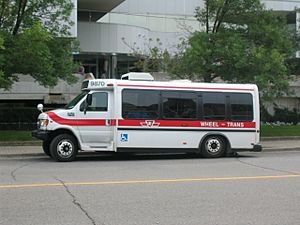Toronto Transit Commission facts for kids
Quick facts for kids Toronto Transit Commission |
|
|---|---|
 Montage of TTC 2.jpg From top-left, clockwise: A Flexity Outlook streetcar, a CLRV streetcar, an S-series rapid transit train, an Orion bus, wall tile signage at Eglinton station featuring the Toronto Subway typeface, a Wheel-Trans bus, and a Toronto Rocket subway train
|
|
| Info | |
| Owner | City of Toronto |
| Locale | Toronto, Mississauga, Vaughan, Markham |
| Transit type | Bus, subway, streetcar |
| Number of lines | 149+ bus routes 4 subway lines 10 streetcar routes |
| Number of stations | 75 in use 39 under construction |
| Daily ridership | 1.69 million weekday passengers |
| Chief executive | Rick Leary |
| Headquarters | William McBrien Building 1900 Yonge Street Toronto, Ontario, Canada |
| Operation | |
| Began operation | 1921 |
| Number of vehicles | 1,869 buses, 752 rapid transit cars, 250 streetcars, 214 Wheel-Trans buses |
| Technical | |
| Track gauge | 4 ft 10 7⁄8 in (1,495 mm) |
The Toronto Transit Commission (TTC) is the public transport system in Toronto, Ontario, Canada. It helps people get around the city using buses, streetcars, and subway trains. The TTC started in 1921 and has grown a lot since then.
Today, the TTC has four subway lines with 75 stations. It also runs over 149 bus and streetcar routes. Many of these routes connect to subway stations, making it easy to switch between different types of transport. The TTC is one of the busiest public transport systems in North America. It's the third most used, after New York City and Mexico City.
The TTC also has a special service called Wheel-Trans. This service is for people with physical disabilities. It picks them up at their home, shops, or work and takes them where they need to go. About 5,500 trips are made by Wheel-Trans every day. It costs the same as a regular TTC trip. In 2007, the TTC had 11,235 people working for it.
Contents
How the TTC Works
The TTC uses different types of vehicles to move people around Toronto. These include buses, streetcars, and subway trains. Each type of transport helps people travel to different parts of the city.
Buses and Streetcars
Buses and streetcars run on the streets of Toronto. They cover many different areas, reaching places the subway doesn't. Buses are very common and can go almost anywhere. Streetcars are like electric trains that run on tracks in the street.
Subway System
The subway system runs mostly underground. It's a fast way to travel long distances across the city. The subway has several lines that connect many important places. There are 75 subway stations in use, and more are being built.
Getting Around with the TTC
The TTC makes it easy for people to travel for work, school, or fun. You can use a Presto card or tokens to pay for your ride.
Paying for Your Ride
To ride the TTC, you need to pay a fare. You can use a Presto card, which is a reloadable card you tap when you enter. Some stations also have paddle-style fare gates that read your Presto card.
Finding Your Way
The TTC has maps and signs to help you find your way. Many bus and streetcar stops have displays that show when the next vehicle will arrive. Subway stations also have large screens with news and service updates.
TTC Headquarters
The main office for the TTC is called the William McBrien Building. It's located at 1900 Yonge Street in Toronto. This building is next to Davisville Yard, which is a place where subway trains are maintained.
Images for kids
See also
 In Spanish: Comité de Tránsito de Toronto para niños
In Spanish: Comité de Tránsito de Toronto para niños

















